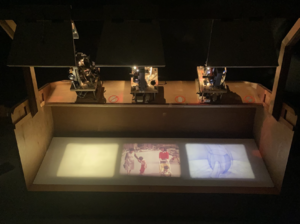Towards the history of East Asian technology: infrastructure and artistic practices
Emilie Choi Sin-yi
What is East Asian media technology? East Asia encompasses not only the geographical region but also the specific geopolitical and sociopolitical conditions in conjunction with the colonial history, technological modernity and post-Cold War structure (Chan, 2006). Adopting East Asia as a crucial framework for illustrating a situated and discursive approach, helps examine the interconnection between the assemblage of media technologies in the region and the urgency of a decolonial perspective.
In the contemporary techno-capitalist landscape characterized by heightened forms of violence operating in a . East Asia remains a significant digital labour market. Many multinational/international corporations employ workers from East Asian regions to maintain the digital systems of the platform economy. For instance, numerous repetitive online tasks (microwork), such as image tagging for machine learning on platforms like Amazon's Mechanical Turk, are outsourced to East Asian workers at low pay rates. This exploitative practice perpetuates the "invisible" digital circuits and reinforces the entanglement of colonialism with techno-capitalism, as well as the power dynamics between the Global North and Global South.
Against this backdrop, this article investigates the construction of infrastructure and its influence on our knowledge, sensibilities, and social relations, drawing from the social history of media technology in East Asia. It explores two aspects: the historical trajectory and its materialist implications, and the articulation of alternative modes of media technology, such as experimental media art, with the reconfiguration of power dynamics between the colonizer and the colonized. Two examples are provided to exemplify how artistic practices utilizing alternative methods of media technology can generate a creative strategy to subvert the colonial narrative and challenge dominant infrastructures.
The first example pertains to Kao Chung-li, a pioneering media artist from Taiwan who subscribes to the belief of "Historical materialism," which posits that the history of technology is dialectically intertwined with its production. Kao asserts that "the only way to redeem our history and future is to develop our own audiovisual machine; the struggle against modern enlightenment and the conclusive victory." Reflecting on this ideology, his artistic practice delves into the perception of war and image-making. Through works like Camera Lucida Cinema (2008), Slideshow Cinema series (2016), and Ballet Mécanique (2014), he employs outdated machines and even invents his own low-budget mechanical projector using nonstandard objects. Embracing a do-it-yourself (DIY) methodology, Kao rejects technological perfection and embraces improvisation. This approach allows him to navigate and bridge gaps in infrastructure, unlocking creative freedom and autonomy.


Another example is the work "Rediscovery of anima" (2018) by Japanese artist Akinori Goto. Goto deviates from digital and industrial technologies, instead relying on stone, wood, hemp, and sunlight to create motion infused with atmospheric elements. This media archaeological approach considers technology as a co-participant with its own agency, suggesting a conceptualization of the subject as a "tool-being." This perspective, situated along the presence-at-hand/readiness-to-hand axis, renews our relationships with material objects and enables new articulations.

By engaging in counter-histories to mainstream media history and seeking alternative ways to comprehend the current media cultural landscape of our digital world, this article aims to contribute to a more nuanced understanding of the intricate interplay between East Asian media technologies, decolonization, and power dynamics.